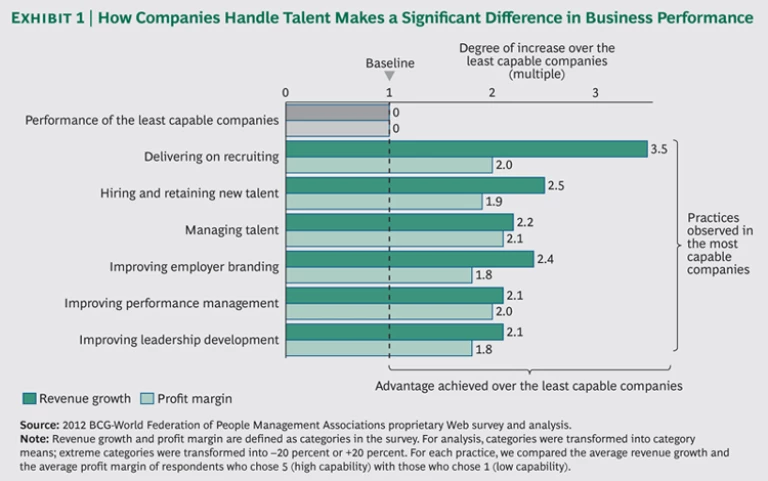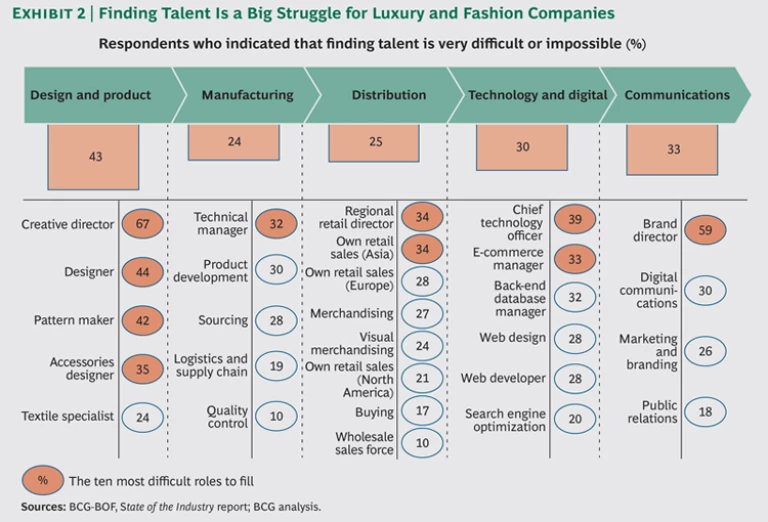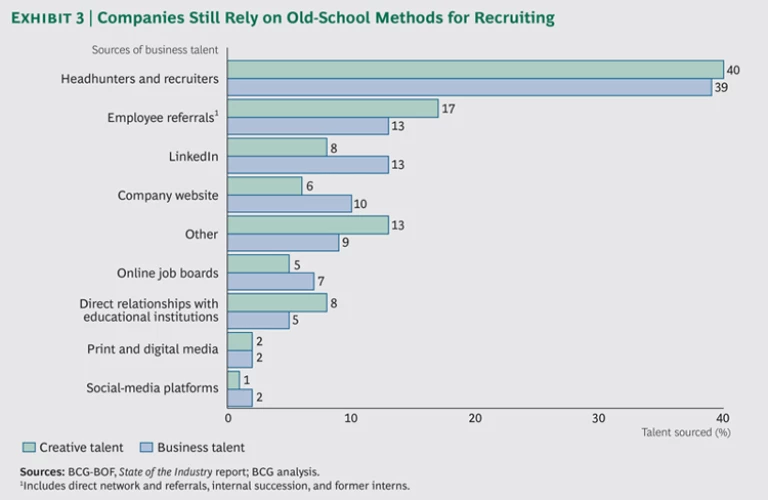Not too long ago, an aspiring young designer from a top-tier school applied for a job with a leading fashion house and was rebuffed. A few years later, after working for a small, nonluxury fashion-design label, he applied again to the name brand house—and clinched the job. What made the difference? This time around, he had developed a portfolio of exciting designs and assembled a beautiful, glossy book to present them, not only displaying great design sensibilities but also demonstrating commitment and determination.
Fashion firms are crying out for top talent. Sure, there is no shortage of young, talented “stylistas” anxious to become the next Tom Ford or Vera Wang. But finding professionals with true creativity who can blend their right-brain talents with the left-brain demands of a range of roles in the increasingly complex fashion business—well, that’s a different story.
The race for top talent will define the next decade for the luxury and fashion industries. A new study by The Boston Consulting Group and the Business of Fashion (BOF) finds that many executives in fashion and luxury, like their peers in other industries, are very concerned about securing talented professionals: 50 percent of respondents believe that they lack access to the best creative
This seems to be an especially pressing concern for smaller independent firms. They worry not only about filling creative roles but also about acquiring the skills needed to support a wide range of functions.
Earlier research by BCG confirms that companies with superior hiring, development, management, and retention practices see clear economic benefits. (See Creating People Advantage 2012: Mastering HR Challenges in a Two-Speed World, BCG report, October 2012.) For example, firms that excel in recruiting enjoy revenue growth that is 3.5 times faster than that of other companies. They also demonstrate profit margins that are twice as robust as those of the laggards. (See Exhibit 1.)
The Four Key Areas of Concern
Luxury and fashion firms have particular concerns in four main areas: recruiting the best talent, cultivating a strong leadership pipeline, building a compelling employer brand, and leveraging digital technology for HR.
Recruiting the Best Talent. Many of the industry’s leaders realize that they have to do more to attract the best employees. The joint study confirms that recruiting challenges persist across the full spectrum of creative and business roles. It also shows that the most difficult jobs to fill are in design and product, followed closely by technology and digital. (See Exhibit 2.) The research highlights specific challenges in each area:
- Design and Product. Top-notch creative directors are particularly scarce: 67 percent of the respondents in our survey said that these professionals are impossible or very difficult to find. The hunt for designers doesn’t fare much better: 44 percent report similar challenges. Technical design also offers a meager pool of talent: 42 percent of those surveyed said that pattern makers are in very short supply. And about one-third of luxury and fashion firms have trouble attracting accessories designers.
- Technology and Digital. The hiring hurdles aren’t much lower for database managers, Web developers, and other technology and digital positions—roles that have generally occupied the back office of the luxury and fashion business but which, in a digital era, have the potential to make a big difference to a company’s market positioning. One-third of the firms surveyed find it very difficult or impossible to hire an e-commerce manager.
It is also becoming more and more difficult to find chief executives and general managers who combine analytical and creative skills; retail, product, and brand expertise; and international experience. Increasingly, the industry’s business leaders are boxed into one function, location, or industry subsector.
Cultivating a Strong Leadership Pipeline. Luxury and fashion firms struggle to cultivate strong leadership pipelines and succession pools for their top executives. Fully 60 percent of those surveyed—from both large and small independent companies—admit to substandard performance in terms of talent management and leadership development.
Interviews and survey findings indicate that many firms are having a tough time gauging the caliber of the talent they currently have—let alone the talent they need. Few of the luxury and fashion firms surveyed have adopted the integrated approach of translating business strategy into HR implications, analyzing current and future demand for talent, and creating career paths that allow high-potential employees to rise through the ranks. By contrast, leading practitioners employ sophisticated tools and processes to understand what skills and capabilities are needed to drive the business, to identify where talent gaps exist today or might occur tomorrow, and to develop plans to close those gaps.
Building a Compelling Employer Brand. Luxury and fashion firms may be masters of their brands—and of product and label branding in general—but those capabilities typically don’t extend to their employer brands. Leading practitioners systematically apply the full suite of brand development tools to attract talent. They ask questions such as the following: What are the best recruiting pools? What is our company’s image, and what do we want it to be? What keeps some people at our firm, and what drives others away?
Leveraging Digital Technology for HR. Digital technology hasn’t fully arrived in the recruiting departments of many luxury and fashion firms. Most of those we surveyed still rely heavily on headhunters and recruiters, and around 40 percent of all new business and creative hires occur through those channels. Most roles are therefore being filled by using old-school methods (in addition to employee referrals). (See Exhibit 3.) Only one in three companies reported using online and social forums to support recruiting efforts—a rate that lags behind those in other industries and falls far below best practice. To be sure, headhunters and recruiters will remain essential for filling many critical leadership roles, but there is abundant opportunity to augment their work with digital approaches.
From a candidate’s perspective, four of the most important recruiting channels are digital: company websites, job portals, online advertising, and social-media pages.
Five Strategies for Securing Talent
Given the findings of the BCG-BOF study, luxury and fashion firms should launch initiatives in five areas to improve their odds of recruiting and retaining the best talent.
Invest in an employer brand. An employer brand has to be built—and nurtured—just as carefully as any product brand. Luxury and fashion firms need to develop specific strategies around employer branding and then allocate dedicated funds to it. Each company must find ways to tell its story and to be clear about how it differs from others as an employer. Then it must identify the right channels to disseminate the story to current employees and potential candidates—and to keep that message very current.
Employ strategic workforce planning. HR teams should work with their business partners to identify the capabilities and capacities needed to deliver the organization’s plans for strategy and growth. They should then map the organization’s current resources against those demands. By comparing the data for demand and supply, companies can quickly see where their most crucial talent gaps lie and start developing discrete action plans to address the shortfall.
Reinforce the use of digital and social media to find the best candidates. We urge companies to overhaul their recruitment processes to shift more of the necessary initiatives toward digital channels, to forge closer links with online hubs that cater to creative work, and to recast more of their efforts in formats that are well suited for digital outlets. These moves have been important in recent years, but they will become downright critical as an even more digitally savvy generation gets ready to join the workforce.
To create a portrait of the firm that will help bolster its employer brand, companies should use a wide variety of digital channels and platforms—from Google+ and LinkedIn networks to targeted e-mail programs. (Popular digital channels such as LinkedIn, however, are usually seen as less useful for creative professionals than for professionals in other fields.) To augment their recruiting strategy, firms will need to reach out more through their websites, a range of job forums, and social media. And to recruit specific candidates, companies will have to ensure that applications are solicited and handled online and that the application process is as streamlined as possible. At the same time, firms should work to improve the ways in which creative portfolios can be shared (and protected) digitally.
Cultivate close relationships with schools. Companies can get closer to pools of fresh talent on both the business and creative sides by forging closer relationships with educational institutions. Students at the University of Virginia Darden School of Business’s fashion and retail club, for example, have made so-called job treks to five fashion firms in New York since 2011. That year, three students attended; the following year, 25 students went on the trip.
Relationships with schools can lead to internships that serve as both an invaluable screening mechanism and an ideal training ground. Firms can work with schools and colleges directly or go through trade associations, such as the British Fashion Council and the Council of Fashion Designers of America; the latter has a number of initiatives that are intended to strengthen the relationships between schools and companies.
Focus on identifying and training tomorrow’s leaders. As the competition for talent heats up, some of the roles that are most in demand are those that combine creative know-how with business acumen. Companies need to identify such talented individuals early on and work hard to create customized programs that attract, develop, and retain them. In particular, firms must do more to hire and promote women leaders. Women are not well represented in the management of companies that sell luxury goods and services—even though they are the major buyers of those goods and services. Of nearly 200 executives at 28 luxury and fashion firms, only about 16 percent are female. Of those companies’ 267 board members, less than 17 percent are women.
As one executive put it, “companies run on people and thrive on talent.” But acquiring and holding onto the required talent will only get more difficult. For a long time, luxury and fashion firms have relied on their storied names alone to keep them above the talent-hunting fray. But as the BCG-BOF survey demonstrates, those days are over: the industry is already feeling the pain that has been experienced for decades by other business sectors.
It’s now time for luxury and fashion firms to compete aggressively and relentlessly for talent. Those that build the strongest people-management capabilities and use the most effective ways to find, develop, and retain their talent will be the ones that outperform for years to come.








